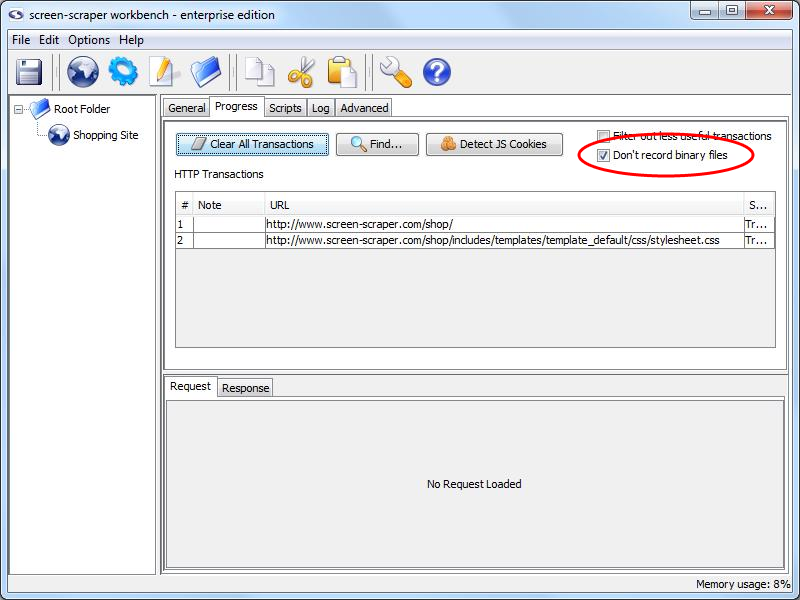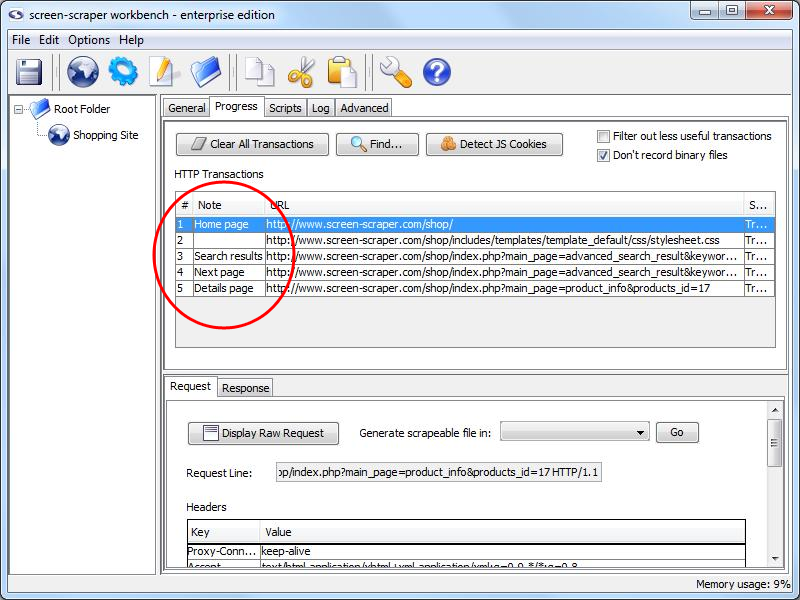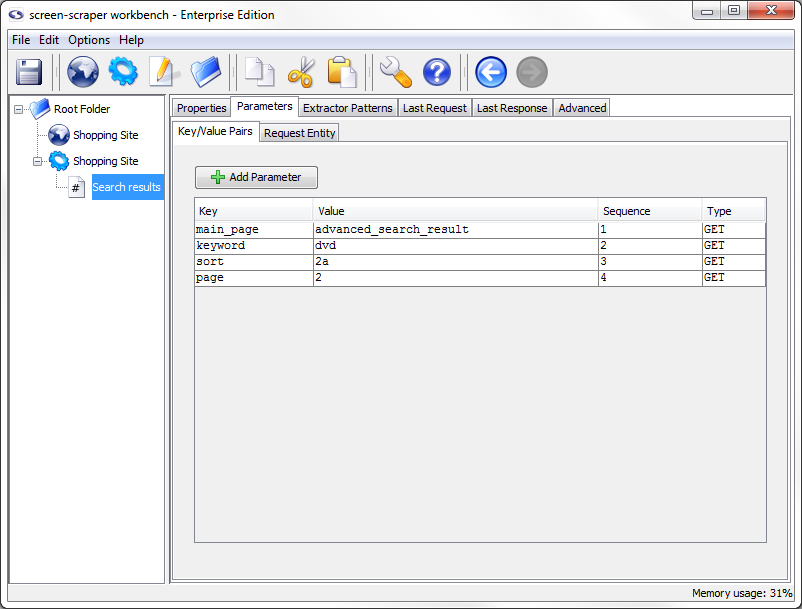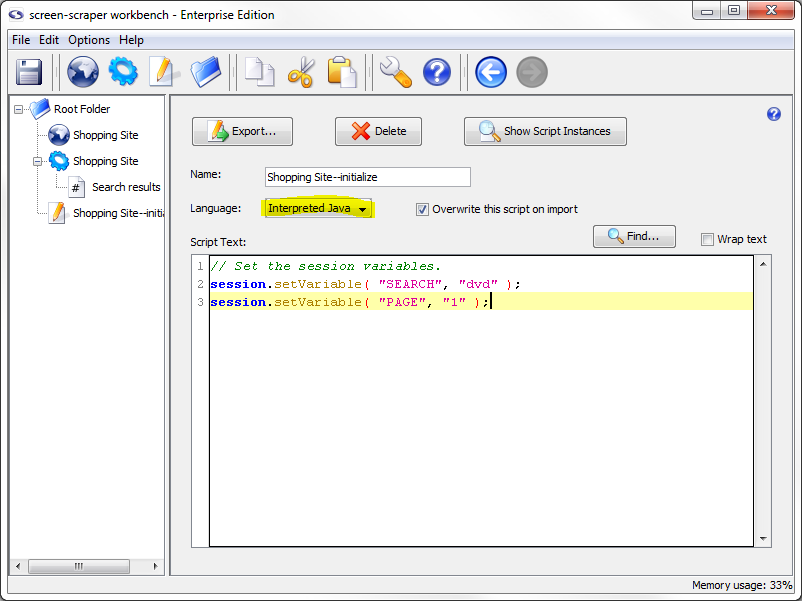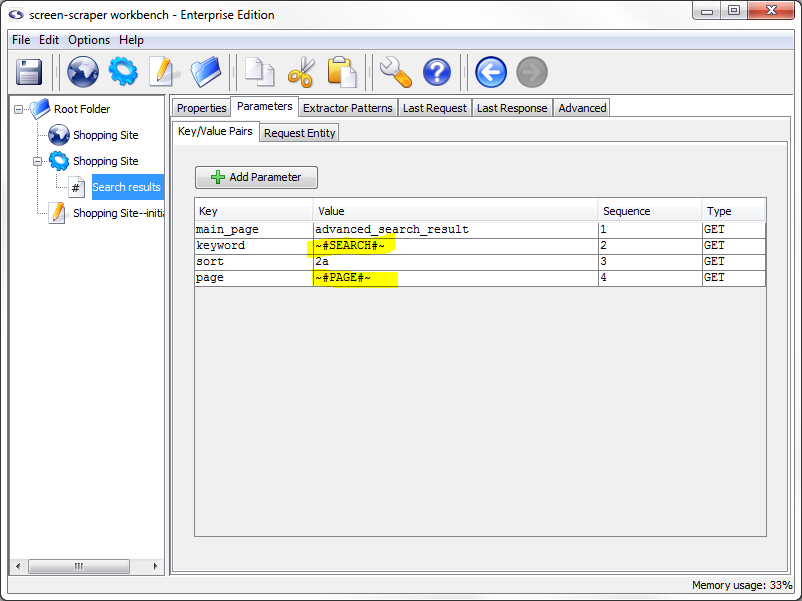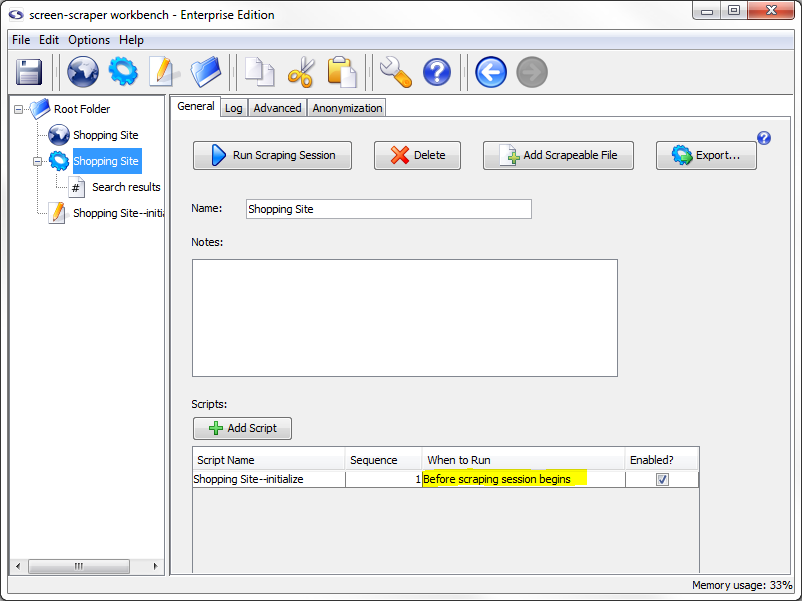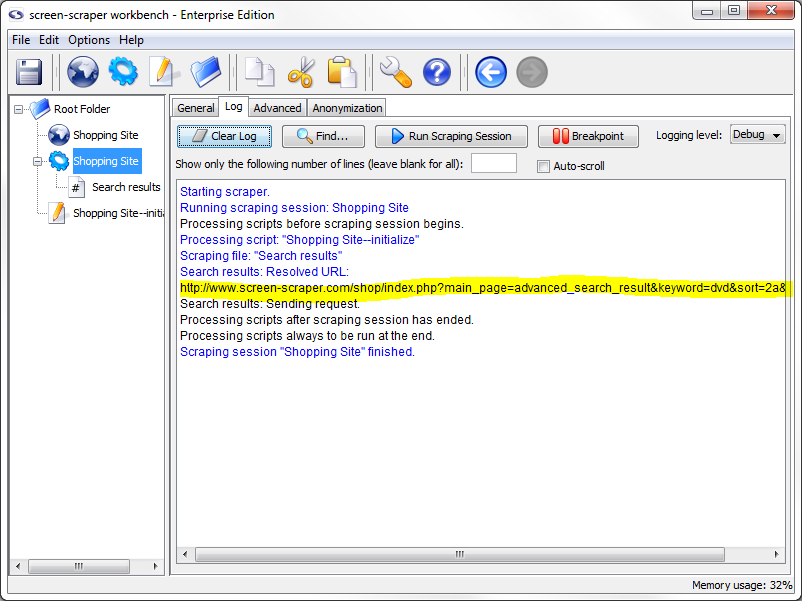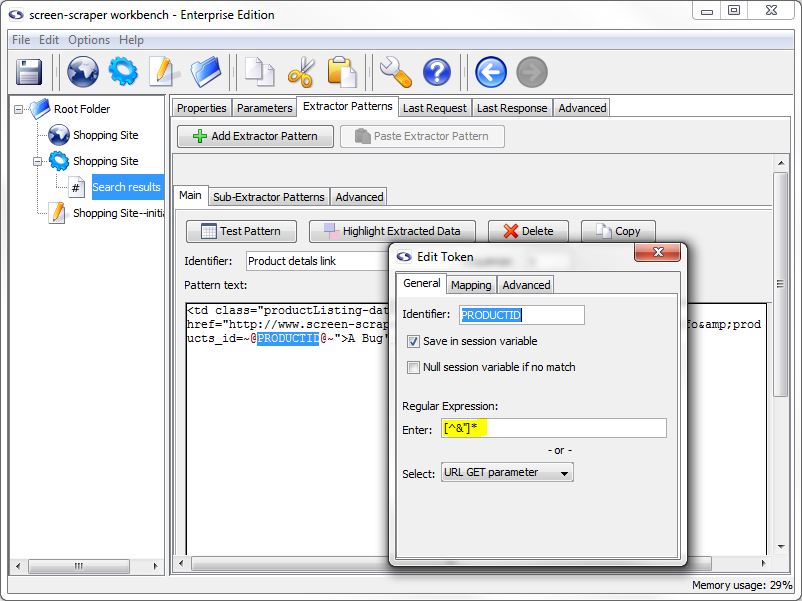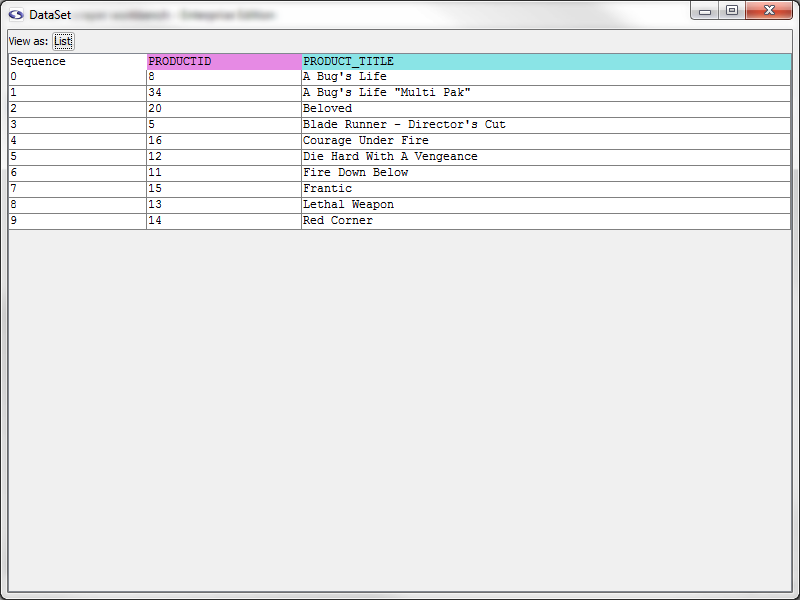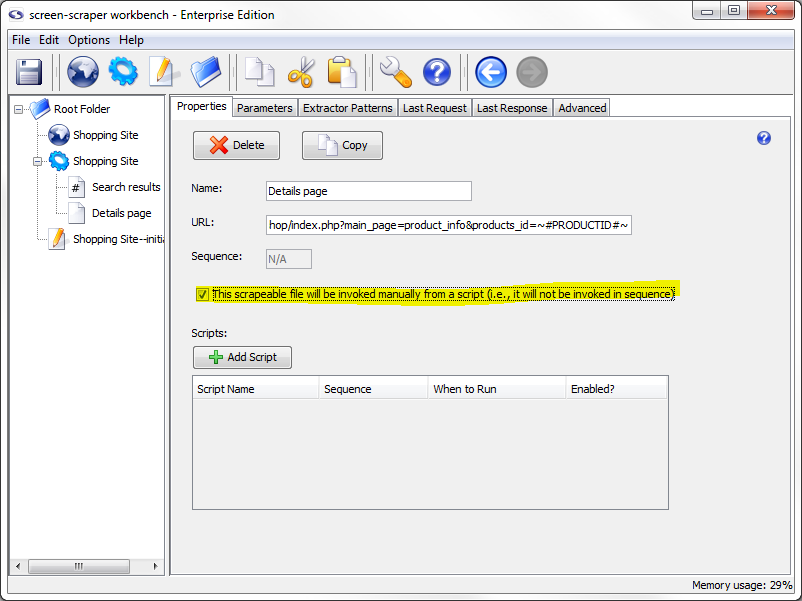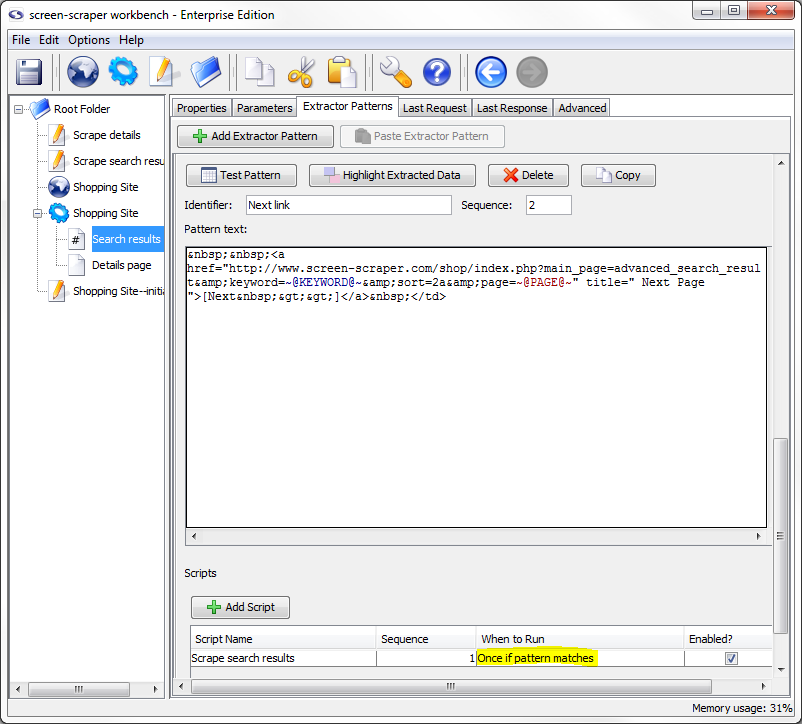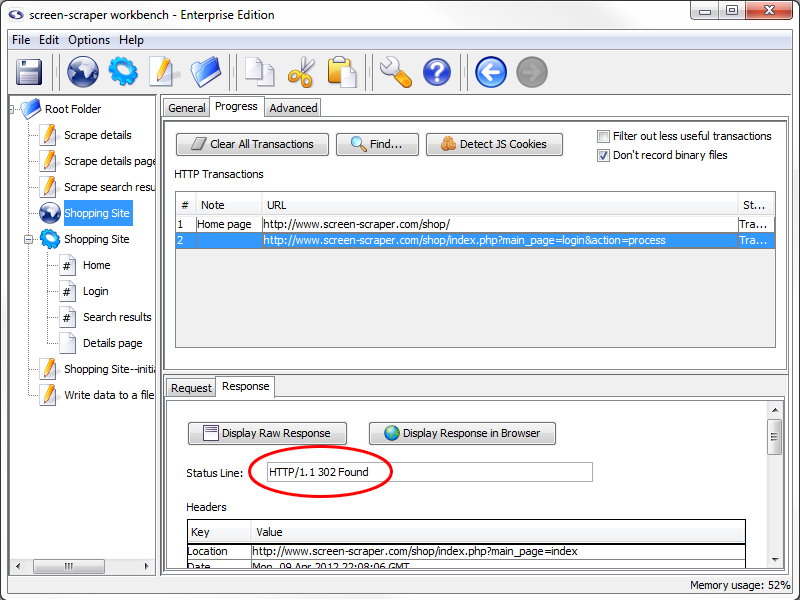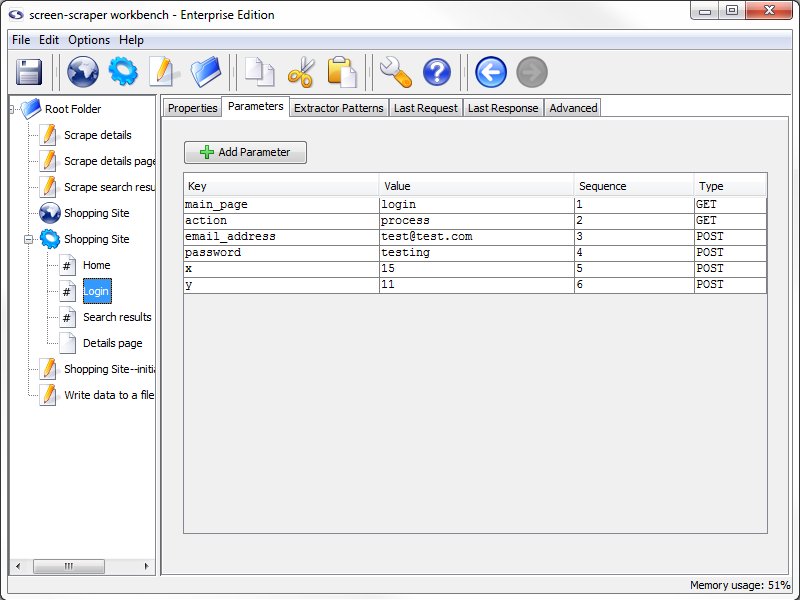Tutorial 2: Shopping Site
Overview
In this tutorial we'll be scraping search results from a basic e-commerce site. We'll also demonstrate logging in to a web site.
If you haven't already gone through Tutorial 1 we'd recommend that you do so before continuing with this one.
You'r welcome to view the final scraping session and output by downloading the two files below. Import the scraping session into screen-scraper.
| Attachment | Size |
|---|---|
| Shopping Site (Scraping Session).sss | 11.36 KB |
| dvds.txt (output) | 897 bytes |
1: Process Review
Screen Scraping Process
As you'll remember from the previous tutorial, extracting information from web sites using screen-scraper typically involves four main steps:
- Use the proxy server to determine the exact files that need to be requested in order to get the information you're after.
- Create a scraping session with scrapeable files that define the sequence of pages screen-scraper will request.
- Generate extractor patterns to define the exact information you need screen-scraper to grab from each page.
- Write small scripts or programming code to invoke screen-scraper and/or work with the data it extracts.




2: Record Search Results
Create Proxy Server
As in the first tutorial, we'll be recording a browser session using the proxy server. Remember that the proxy session records all of the HTTP requests and responses that take place between your browser and the target server.
Create a new proxy session now by clicking the New Proxy Session button and name it Shopping Site.
Configure Proxy Server
At this point start up the proxy server by clicking the Start Proxy Server button, then configure your web browser as you did in the first tutorial (if needed use our documentation on configuring your browser).
In your web browser (after configuring it to use the proxy server) go to this URL: http://www.screen-scraper.com/shop/.
Remember that you may want to use one browser with the proxy server and one to view the tutorial.
Make sure to check Don't record binary files.
Record Pages
Search Results Page
We'll be doing a search in the shopping web site for the term "dvd" in the product catalog. Do this by typing dvd into the search box located in the upper-right corner of the home page, then click the Search button. You'll see screen-scraper work for a bit, then, once it finishes, you should see one new row in the HTTP Transactions table.
Add a note, Home page to the appropriate transaction by double-clicking in the notes field and typing it.
Add a note, Search results to the appropriate transaction by double-clicking in the notes field and typing it.
Next Page
We'll want to traverse all of the search results, so, in your web browser, click the Next >> link.
Add a note, Next page.
Details Page
Later on we'll be scraping the details pages, so let's record one of those now. Click on the link for Speed to view the details on this DVD.
Add a note, Details page.
Stop Proxy Session
These are the only pages we're interested in at this point, so go ahead and stop the proxy session by clicking the Stop Proxy Server button on the General tab. You'll also want to re-configure your browser so that it's no longer using screen-scraper as a proxy server.
Note column in HTTP Transactions table.
3: Creating the Scrape
Create the Scraping Session
Create a scraping session by clicking the (Add a new scraping session) button.
In the Name field enter Shopping Site (if you already downloaded and imported the scraping session at the first of this tutorial you'll want to name your scraping session something else, perhaps "My Shopping Site").
A scraping session is simply a container for all of the files and other objects that will allow us to extract data from a given web site.
Add Scrapeable Files

We'll now be adding scrapeable files to our scraping session. You'll remember from the first tutorial that a scrapeable file represents a web page you'd like screen-scraper to request.
Add the first scrapeable file to the scraping session by clicking the Shopping Site proxy session in the objects tree, then on the Progress tab. Find the Next page note in the HTTP Transactions table, the URL should look something like:
This URL corresponds to the second page in the search results. We'll use this file because it should contain all of the parameters in the URL we need to request any of the search results pages (including the first).
After clicking on this row in the table, information corresponding to the file will appear in the lower pane. Add the file to the Shopping Site scraping session by selecting it in the Generate scrapeable file in drop-down list, and clicking the Go button.
After the scrapeable file appears under the scraping session rename it to "Search results".
Scrapeable File Parameters
Next, click on the Parameters tab.
When we generate a scrapeable in this way screen-scraper pulls out the parameters from the URL and puts them under the Parameters tab for us. Because these are GET parameters (as opposed to POST parameters), when the scrapeable file is invoked by screen-scraper in a running scraping session, the parameters will get appended again to the URL. Let's take a closer look at each of the parameters that were embedded in the URL:
- main_page: advanced_search_result
- keyword: dvd
- sort: 2a
- page: 2
The only two that we're likely interested in are keyword and page. We can guess that keyword refers to the text we typed into the search box initially. The page parameter refers to what page we're on in the search results. We can guess that if we were to replace the 2 in the page parameter of the URL it would bring up the first page in the search results. Try this by bringing up the following page in your web browser:
Looks like our theory was correct. You should see the first page of search results. It's also important to note that the keyword and page parameters are those that will need to be dynamic.
4: Initialization Script
What is an Initialization Script
It's a common practice to run a script at the very beginning of a scraping session that can initialize variables and such. It is especially useful in a site that iterates over multiple pages, like our little shopping site.
Creating the Script
Generate the script either by clicking the (Add a new script) button or by selecting New Script from the .
In the Name field type Shopping Site--initialize session.
You'll remember from the first tutorial that screen-scraper scripts get invoked when certain events occur. We'll be invoking this script before the scraping session begins but first let's write the script.
Writing the Script
Once again, this tutorial is not to teach Java so we will provide you with the script. Please copy and paste it into the Script Text field in your script.
session.setVariable( "SEARCH", "dvd" );
session.setVariable( "PAGE", "1" );
Ensure that Interpreted Java is selected in the Language.
In the script, we set two session variables on our current scraping session. We start the PAGE variable at 1 so that the first search results page will get requested first.
Using Session Variables in Scrapeable File Parameters
Before trying out this script let's modify the parameters for our scrapeable file so that they make use of the session variables. Click on the Search results scrapeable file, then on the Parameters tab.
Change the value of the keyword parameter from dvd to ~#SEARCH#~, and change the value of the page parameter from 2 to ~#PAGE#~.
If you remember from the first tutorial we used the delimiters ~@ and @~ to select information out of an extractor pattern and we also saved the selected information into session variables. The delimiters ~# and #~ do almost exactly the opposite; they take session variables and place them into our files instead of taking them out.
The ~#SEARCH#~ and ~#PAGE#~ tokens will be replaced at runtime with the values of the corresponding session variables. As such, the first URL will be as follows:
That is, screen-scraper will take all of our GET parameters, append them to the end of the URL, then replace any embedded session variables (surrounded by the ~# #~ markers) with their corresponding values.
Alternative Method
We could achieve the same effect by deleting all of the parameters from the Parameters tab, and replacing the text in the URL field with the whole GET URL:
Breaking out the parameters under the Parameters simply makes them easier to manage, which is why we have taken that approach.
Associating the Script
We'll now need to associate our script with our scraping session so that it gets invoked before the scraping session begins.
To do that, click on the Shopping Site scraping session in the objects tree, then on the General tab.
In the Scripts section, towards the bottom of the pane, click the Add Script button to add a script.
In the Script Name column select Shopping Site--initialize session. Then, in the When to Run column select Before scraping session begins (if not already selected), and make sure that the Enabled checkbox is checked. This will cause our script to get executed at the very beginning of the scraping session so that the two session variables get set.
Test Run
All right, we're ready to try it all out. This scraping session will, once finished, generate a longer log than the one that the first tutorial created, so it may be a good idea to increase the number of lines screen-scraper will display in its log. To do that, click on the scraping session in the objects tree, then on the Log tab. In the text box labeled Show only the following number of lines enter the number 1000.
As you might guess, if you simply remove the number from the box then it will allow the logs to grow as much as it needs to to keep all of the information for the scrape. Really long files will slow down the scrape, so if it starts to get too long it is best to limit the size of the log.
Run the scraping session by selecting it in the objects tree, then clicking the Run Scraping Session button. This will cause the Log tab to be activated, allowing you to watch the scraping session progress.
You'll notice that the URL of the requested file is the one given above. You can also verify that the correct URL was requested by clicking on the Search results scrapeable file, then on the Last Response tab, then on the Display Response in Browser button. The page should resemble the one you saw in your web browser.
Remember that it's a good idea to run scraping sessions often as you make changes, and watch the log and last responses to ensure that things are working as you expect them to. You'll also want to save your work frequently. Do that now by hitting the (Save) button.
5: Link Extractor Patterns
Warning!
This particular part of the tutorial is one that covers important principles that often seem confusing to people at first. If you've been speeding through the tutorial up to this point, it would probably be a good idea to slow down a bit and read more carefully.
Extractor Pattern Review
We're now going to create a couple of extractor patterns to extract information for the next and the product details links.
Remember that an extractor pattern is a block of text (usually HTML) that contains special tokens that will match pieces of data you're interested in gathering.
When creating extractor patterns it is recommend that you always use the HTML from the Last Response tab in screen-scraper. By default, after screen-scraper requests a page it tidies the HTML found in it. This causes it to differ slightly from the HTML that you would get by viewing the source in your web browser.
Identifying the Details URL
Click on the Search results scrapeable file in the objects tree, then on the Last Response tab. The textarea contains HTML because we just ran the scraping session.
If you are not seeing any HTML then re-run the scraping session so that the scrapeable file will have a last response.
We're going to extract a portion of each of the product details links so that we can subsequently request each details page and extract information from them. The first details link corresponds to the A Bug's Life DVD.
To find the text, you can click the Find button, then type A Bug's Life into the Find what textbox, and click the Find button. Let's start by looking at all of the table row (<tr> tag). You might not be able to easily see all of the text so we have extracted it and placed it here for you to examine:
<td align="center" class="productListing-data"> <a href="http://www.screen-scraper.com/shop/index.php?main_page=product_info&products_id=8"><img src="images/dvd/a_bugs_life.gif" border="0" alt="A Bug's Life" title=" A Bug's Life " width="100" height="80" /></a> </td>
<td class="productListing-data"> <a href="http://www.screen-scraper.com/shop/index.php?main_page=product_info&products_id=8">A Bug's Life</a> </td>
<td align="right" class="productListing-data"> $35.99 </td>
<td align="center" class="productListing-data"><a href="http://www.screen-scraper.com/shop/index.php?main_page=advanced_search_result&keyword=dvd&sort=2a&page=1&action=buy_now&products_id=8"><img src="includes/templates/template_default/buttons/english/button_buy_now.gif" border="0" alt="Buy Now" title=" Buy Now " width="60" height="30" /></a> </td>
</tr>
This may seem like a bit of a mess, but if we look closely we can pick out the table cell that the details link is in:
Breaking it down a bit more we get the URL:
You might notice that the typical & symbols in the URL have been replaced with &. Don't be alarmed, it's just part of the tidying process screen-scraper applies to the HTML.
If we examine the parameters in the URL, we can guess that the important one is products_id, which likely identifies the product whose details we're interested in. We'll start by assuming that the products_id is the only one we'll need to extract.
Creating the Product Details Link Extractor Pattern
At this point, click on the Search results scrapeable file in the objects tree, then click on the Extractor Patterns tab. We'll create an extractor pattern to grab out the product ID and DVD title for each link. It will look like the one shown below:
Create the extractor pattern by clicking on the Add Extractor Pattern button, then copying and pasting the text above into the Pattern text box.
Give the extractor pattern the name Product details link. Remember that extractor tokens (delineated by the ~@ @~ markers) indicate data points we're interested in gathering. In this case, we want to extract the ID of the product (embedded in the URL), and the title of the product.
PRODUCTID Token Properties
Double-click the PRODUCTID token (or select the text between the ~@ @~ delimiters, right-click it and select Edit token), and, in the box that appears, click the Save in session variable checkbox. Under the Regular Expression section, select URL GET parameter. You'll notice that when you do that the text [^&"]* shows up in the text box just above the drop-down list. This is the regular expression that we'll be using. You could also edit it manually, but generally that won't be needed.
PRODUCTID Properties Set
Quick Explanation
Let's slow down at this point and go over what we just did to the PRODUCTID extractor token.
In the first tutorial we checked the Save in session variable box telling screen-scraper to preserve the value for us so that we could use it at a later point. This time we also selected a regular expression for it to use. This will filter out the results that don't meet the expectations of the token.
If you're not very familiar with regular expressions, don't worry. In the vast majority of cases you can simply use the regular expressions found in that drop-down list.
By indicating the URL GET parameter regular expression we're saying that we want the token to match any character except a double-quote or an ampersand (i.e., the " and & characters). You'll notice in our extractor pattern that a double-quote character just follows our PRODUCTID extractor token. By using a regular expression we limit what the token will match so that we can ensure we get only what we want. You might think of it as putting a little fence around the token. We want it to match any characters underneath the PRODUCTID extractor token, up to (but not including) the double-quote character.
You will, most of the time, want to designate a regular expression for extractor tokens. It will help ensure that you only retrieve the desired information.
In most cases you'll want to designate a regular expression for extractor tokens. Using regular expressions also makes extractor patterns more resilient to changes in the web site. That is, if the web site makes minor changes to its HTML (e.g., altering a font style or color) and you've been using regular expressions your extractor patterns are more likely to still match. Also, by using regular expressions we can often decrease the amount of HTML we need to use in our extractor patterns. That is, by using regular expressions we indicate more precisely what the data will look like that our tokens will match. By doing this, we can often reduce the amount of HTML we include at the beginning and end of our extractor patterns. In general, if you can reduce the amount of HTML in your extractor patterns, and increase the number of regular expressions you use in tokens, your extractor patterns will be more resilient to changes that get made in the HTML of the pages.
Now close the Edit Token box (which saves our settings automatically).
PRODUCT_TITLE Token Properties
Now let's alter the settings for the PRODUCT_TITLE token. We're not interested in saving the value for this token in a session variable, but we include it since it will differ for each section of HTML we want to match.
Double-click the PRODUCT_TITLE extractor token to bring up the Edit token dialogue box and, under the Regular expression section, select Non-HTML tags. If you take a look at the characters on the left and right sides of our PRODUCT_TITLE extractor token, you will see that they are less than (<) and greater than (>) symbols. By using this regular expression we tell the extractor token not to include either symbol. This way we create a boundary for the token so that we can ensure it matches only what we want it to.
Why even include an extractor token for data we don't want to save? By using extractor tokens for data we don't necessarily want to save, we make the extractor pattern more resilient to changes in the HTML. These extra tokens can help "future proof" our extractor patterns against changes the site owners might make down the road. There are also often situations (such as the present one) where data points adjacent to data we want to extract will differ for each pattern match. Here we only want the product ID, but we also include the product title because of its proximity to the data we want to extract, and because its value will differ each time the extractor pattern matches.
If that strikes you as a little bit confusing, don't worry. As you get more experience using screen-scraper you'll see why they're important. For now just take our word for it that you'll generally want to use regular expressions with extractor pattern tokens, and that it's often a good idea to use extractor tokens to match data points you don't necessarily want to save. As you get more experience it will become more apparent when to use extractor tokens for data you don't want to save.
Extractor Pattern Test
Let's give our new extractor pattern a try. Click the Test Pattern button. You should see a window come up that shows the extracted data.
Data Set for Product details link Pattern
Again, let's slow down a moment and review what this window contains. When an extractor pattern matches, it produces a DataSet. You can think of a DataSet like a spreadsheet--it contains rows, columns, and cells. Each row in a DataSet is called a DataRecord. A DataRecord can be thought of as being analogous to a row in a spreadsheet. In this particular case our DataSet has three columns. Two of them should be familiar--they correspond to the PRODUCT_TITLE and PRODUCTID extractor tokens. The Sequence column indicates the order in which each row was extracted. You'll notice that the sequence is zero-based, meaning the first DataRecord in the DataSet is referenced with an index of 0. You'll also notice that the DataSet has 10 records--one for each product found in the search results page.
Later, when we start talking more about DataSets and DataRecords, just remember the spreadsheet analogy: a DataSet is like the entire spreadsheet, and a DataRecord is like a single row in the spreadsheet.
Another good habit to get into is applying your extractor patterns frequently to ensure they correctly match the text you want extracted.
Go ahead and close the DataSet window now.
Creating the Next Link Extractor Pattern
Back in the last Response tab, search for the text "Next". Around the area you'll find HTML for the link:
Fortunately, because of our work with the initialize script, we are already familiar with the URL and know that the only parameters we need to worry about are keyword and page.
Create a new extractor pattern, call it Next link, and use the following extractor pattern to grab the values of those parameters out:
PAGE Token Properties
As with the previous extractor pattern, double-click the PAGE token, and, in the box that appears, click Save in session variable checkbox.
Under the Regular Expression section, select Number from the Select drop-down list.
Close the "Edit Token" box to save your settings.
The Number regular expression ([\d,]+) simply indicates that we only want the PAGE token to match numbers (the regular expression essentially says, "match anything that contains either numbers or commas, and has at least one of either of those types of characters in it.").
KEYWORD Token Properties
Next, double-click the KEYWORD extractor pattern token to edit it. Under the Regular Expression section, select URL GET parameter from the Select drop-down list.
This indicates that the KEYWORD extractor pattern should match only characters that would be found in a GET parameter of a URL. You'll notice that we didn't check the box to save the KEYWORD extractor pattern token in a session variable. We already have that value in a session variable, so we don't need to bother with getting it again.
Extractor Pattern Test
Try out the extractor pattern by clicking the Test Pattern button. Excellent! We have two matches: one for each next link on the page (the top and bottom of the page).
Save
Now would be a good time to save your work. Do that by selecting Save from the or by clicking the (Save) icon.
Test Run
OK, let's try out the whole thing once more. Click on the Shopping Site scraping session in the objects tree, then on the Log tab. Click the Clear Log button, we're going to run it again and we don't want to get confused by the log text from the last run, then click the Run Scraping Session button to start it.
You should see a bit more text in the log this time, as opposed to last time. Take a minute to look through it to ensure you understand what's going on.
6: Page Scraping Script
Page Scraping Script Explanation
For each details link we're going to scrape the corresponding details page. This is a common scenario in screen-scraping: given a search results page, you need to extract details for each product, which means following each of the product details links. For each details page you'll likely want to extract out pieces of information corresponding to the products.
Details Scrapeable File
Let's start by creating a scrapeable file for the details page. We could create it from the proxy session; but, because it's pretty simple, let's just create it from scratch.
Click on the Shopping Site scraping session, then the General tab, then the Add Scrapeable File button.
Give the scrapeable file the name Details page, and the following URL:
You'll notice that this time we're leaving all of the parameters embedded in the URL. Sometimes with shorter URL's it's more convenient to take this approach rather than breaking them out under the Parameters tab.
As before, when the scraping session runs, the PRODUCTID token will be replaced by the value of the PRODUCTID session variable.
At this point, click the This scrapeable file will be invoked manually from a script checkbox. If we didn't do this, screen-scraper would invoke this scrapeable file in sequence (after the search results page), which we don't want. Instead, we're going to tell screen-scraper to invoke this scrapeable file from a script.
You might have noticed that by checking the This scrapeable file will be invoked manually from a script checkbox the symbol of the scrapeable file changed from (sequenced scrapeable file) to (non-sequenced scrapeable file. This change will cause the non-sequenced file to move to the bottom of the scrapeable files and be sorted alphabetically with other non-sequenced scrapeable files.
Write Script
First, create a new script and call it Scrape details page, then enter the following code in the Script Text
session.scrapeFile( "Details page" );
Adding Details Script Association
OK, this is where we need to take a moment to think: for each product ID our Product details link extractor pattern extracts, we want to scrape the product details page using the corresponding PRODUCTID. So the script needs to run after each time the pattern matches.
To add the association, go to the Product details link extractor pattern by clicking the Search results scrapeable file, then the Extractor Patterns tab. Notice the Scripts section under the extractor pattern. Click the Add Script button to add a script association. In the Script Name column, if it isn't already selected, select our Scrape details page script and under the When to Run column, select After each pattern match.
Let's walk through that a bit more slowly. After the search results page is requested the Product details link will be applied to the HTML in the page. Remember that this particular extractor pattern will match 10 times: once for each product details link. Each time it matches it will grab a different product ID and save the value of that product ID into the PRODUCTID session variable. The Scrape details page script will get invoked after each of these matches, and each time the PRODUCTID session variable will hold a different product ID. As such, when the Details page gets scraped the URL will get a different product. For example, the first time the extractor pattern matches the PRODUCTID session variable will hold "8", and the URL will be:
But, the next time, the product ID will be 34 and the URL will be:
If it helps, think again about the spreadsheet analogy. You can imagine screen-scraper walking through each row in the spreadsheet. It encounters a row, saves any needed data in session variables (the product ID, in this case), then invokes the Scrape details page script. Because it just matched a specific product ID, and saved its value in a session variable, when the Details page scrapeable file gets invoked by the script, the current product ID in the PRODUCTID session variable will be used. Once it's finished invoking the Details page scrapeable file, it will go on to the next row (or DataRecord) in the spreadsheet (or DataSet). Again, it will save the product ID in a session variable, then execute the Scrape details page script, which in turn invokes the Details page scrapeable file. Because we indicated that the script should be invoked After each pattern match, this will occur 10 times--once for each search result. If we had designated After pattern is applied, the script would only have been executed once: after it traversed the spreadsheet and reached the very end.
This is another area that people new to screen-scraper find confusing, so it's probably worth it to slow down a bit and ensure you understand what's going on.
Test Run
Now would be a good time to try out the whole scraping session again. Do what you did before by clearing out the log for the scraping session, then clicking the Run Scraping Session button. You'll see each details page getting requested one-by-one. Note especially each URL, which will have a different product ID at the end of each. If you'd prefer not to wait for the entire session to run you can click the Stop Scraping Session button.
As before, it would be a good idea to go through the log carefully to ensure that you understand what it's doing.
Scrape Search Results Script
At this point we still need to deal with the next page link. We already have an extractor pattern to grab out the page number of the next page. Let's create a script to scrape the search results page again for each next link.
Generate a new script and call it Scrape search results. Enter the following in the Script Text field:
session.scrapeFile( "Search results" );
Notice that we have only one line of code, short and simple, which will scrape the Search results scrapeable file when it is invoked.
Add Scrape Search Results Script Association
Return to the Next link extractor pattern and click the Add Script button to add a script association. Select the Scrape search results script.
This time there's something slightly different we'll need to do under the When to Run column. If you remember our extractor pattern matched twice (you can see this on the previous page). The problem is that we only want to follow the Next link once (that is, we don't want to scrape the second page twice). This is easily dealt with by selecting Once if pattern matches under the When to run column.
In other words, the script will only get invoked once and only if the extractor pattern has a match. Selecting Once if pattern matches under the When to run column guarantees that the script will get invoked once and only once regardless of the number of matches it finds. So, even though we have two matches for the Next link extractor pattern, the Scrape search results script will only be invoked once, which means that the Search results will only be scraped once.
Test Run
OK, run the scraping session once more. Clear the scraping session log, then click the Run Scraping Session button. If you let it run for a while you'll notice that it will request each details page for the products found on the first search results page, request the second search results page, then request each of the details pages for that page.
7: Extract Product Details
Warning!
At this point we're able to scrape the details pages for each of the products. We're now ready to extract the information we're really interested in: data about each DVD. To do this we're going to use sub-extractor patterns. Again, this is a point in the tutorial where you may want to slow down a bit. Sub-extractor patterns is another important concept that can be a bit confusing at first.
Sub-Extractor Pattern Explanation
Sub-extractor patterns allow us to define a small region within a larger HTML page from which we'll extract individual snippets of information. This helps to eliminate most of the HTML text we're not interested in, allowing us to be more precise about the data we'd like to extract. It also makes our extractor patterns more resilient to future changes in the HTML page, as they allow us to reduce the amount of HTML we need to include.
If you let the scraping session run through to completion the last URL in the scraping session log will be the one listed here:
If that's not the exact one you have, don't worry; it won't make a difference for our extractor patterns.
We'll need to examine the HTML for a details page in order to generate the extractor patterns. Do this by clicking on the Details page scrapeable file in the objects tree, then on the Last Response tab. You'll remember that screen-scraper records the HTML for the last time each page was requested.
To visualize what we will be doing, bring up the URL above in your web browser. Notice the DVD title, price, model, shipping weight, and manufacturer; these are the pieces of information that we are interested in gathering.
It should be apparent in examining the page that most of the elements on it aren't of interest to us. For example, we don't care about the header, footer, or any of the boxes along the sides of the page.
Creating the DATARECORD Extractor Pattern
We'll first use our extractor pattern to define a region that basically surrounds the elements we're interested in.
Scroll down until you see a few lines of HTML code where the DVD title is surround by h1 tags.
<td colspan="2" class="pageHeading" valign="top">
<h1>You've Got Mail</h1>
Highlight the block of HTML from the opening <tr> tag down to the word Quantity.
<td align="center" class="cartBox"> Quantity
Your selection should look something like this.
<td colspan="2" class="pageHeading" valign="top">
<h1>You've Got Mail</h1>
</td>
</tr>
<tr>
<td align="center" valign="top" class="smallText" rowspan="2">
<script language="javascript" type="text/javascript">
<!--
document.write('<a href="javascript:popupWindow(\'http://www.screen-scraper.com/shop/index.php?main_page=popup_image&pID=7\')"><img src="images/dvd/youve_got_mail.gif" border="0" alt="You\'ve Got Mail" title=" You\'ve Got Mail " width="100" height="80" hspace="5" vspace="5" /><br />larger image<\/a>');
//-->
</script>
<noscript><a href="http://www.screen-scraper.com/shop/index.php?main_page=images/dvd/youve_got_mail.gif" target="_blank"><img src="images/dvd/youve_got_mail.gif" border="0" alt="You've Got Mail" title=" You've Got Mail " width="100" height="80" hspace="5" vspace="5" /><br />
larger image</a></noscript> </td>
<td class="main" align="center" valign="top">Model: DVD-YGEM</td>
</tr>
<tr>
<td class="main" align="center"></td>
</tr>
<tr>
<td align="center" class="pageHeading">$34.99</td>
<td class="main" align="center">Shipping Weight: 7.00 lbs.</td>
</tr>
<tr>
<td> </td>
<td class="main" align="center">9 Units in Stock</td>
</tr>
<tr>
<td class="main" align="center">Manufactured by: Warner</td>
<td align="center">
<table border="0" width="150px" cellspacing="2" cellpadding="2">
<tr>
<td align="center" class="cartBox"> Quantity
Now, right-click on the highlighted text and choose Generate extractor pattern from selected text. You'll be automatically taken to the Extractor Patterns tab.
In the Pattern Text field highlight from just after...
class="pageHeading"
...to just before the word "Quantity".
class="cartBox">
Right-click on your selection and choose Generate extractor pattern token from selected text. In the window that opens type DATARECORD in the Identifier textbox and close the window by clicking on the X in the upper right-hand corner. Don't worry settings are saved when the window closes.
Notice that we simply replaced most of the middle portion of the large block of HTML with a DATARECORD token. If you look at the text before and after ~@DATARECORD@~ you can see that it is the same text that could be found at the beginning and end of the large HTML block.
The basic idea here is to include only as much HTML around the sub-region as necessary to uniquely identify it in the page. Any of the HTML covered by the DATARECORD token will be picked up by screen-scraper, and will define our sub-region that we'll be extracting the individual pieces of data from.
Now click the Test Pattern button. In the window that appears, copy the text from the DATARECORD column and paste it into your favorite text editor.
The easiest way to select all of the text in that box is to triple-click it, use the keyboard to copy the text (Ctrl-C in Windows and Linux), then paste it into your text editor. The text should look like this:
This is the HTML we're after, but it's all in one large block. This occurs because screen-scraper strips out unnecessary white space when extracting information in order to make the extraction process more efficient. This can make sifting through the HTML a little more difficult, but the search feature should make this relatively straightforward.
Adding Sub-Extractor Patterns
For creating the sub-extractor patterns, you are welcome to use the code snippit in your text editor or the HTML found directly in the Last Response tab (just be sure that you're only grabbing portions of the page that would be covered by the DATARECORD extractor token).
First off, we're interested in the DVD title. In your text editor do a search for the first word in the title of the DVD whose page you're viewing (e.g., if you're viewing the HTML for the last DVD in the search results you'll search for You've, since the movie is "You've Got Mail"). This should highlight the first word in the title. In order to extract this piece of information we'll use a small sub-extractor pattern:
Once again, we include only as much HTML around the piece of data that we're interested in as is necessary. If we do this just right we'll still be able to extract information even if the web site itself makes minor changes.
TITLE Sub-Extractor Pattern
To add a sub-extractor pattern, on our PRODUCTS extractor pattern, click the Sub-Extractor Patterns tab, then the Add Sub-Extractor Pattern button.
In the text box that appears paste the text for the sub-extractor pattern we've included above. Edit the TITLE extractor token by double-clicking it and, under the Regular Expression section, select Non-HTML tags from the drop-down list (as a side note, this is probably the most common regular expression you'll use). Click on the Test Pattern to try it out. You should see a DataSet with a single row and columns for the DATARECORD and TITLE tokens.
DataSet for Title Sub-Extractor Pattern
You might have a different TITLE if you stopped your scraping session at different point of time. This doesn't mean you are doing wrong. Just make sure that a title does show up. If not then you have an error in one of your extractor patterns.
Other Sub-Extractor Patterns
Create the following sub-extractor patterns for the remaining data elements we want to extract (note that each box should be a separate sub-extractor pattern):
For each token in the sub-extractor patterns give it the Non-HTML tags regular expression, same as you did with the TITLE extractor token.
As sub-extractor patterns match data, they aggregate the pieces into a single data record. That means that for each extractor token only one value can exist.
A sub-extractor pattern cannot match multiple times. It will take only its first match and all other potential matches will be discarded.
When our PRODUCTS extractor pattern is applied along with its sub-extractor patterns, a single data record is created. This can be seen by clicking on the Test Pattern button:
Final DataSet for PRODUCTS extractor pattern
Test Run
If you'd like, at this point try running the scraping session again by clearing the log and hitting the Run Scraping Session button. If you examine the log while the session runs you'll see that it extracts out details for each of the DVDs.
8: Saving the Data
Processing Collected Information
Once screen-scraper extracts data there are a number of things that can be done with it. For example, you might be invoking screen-scraper from an external script (e.g., ASP, PHP, Java, etc.), which, after telling screen-scraper to extract data for a given search string, might display the results to the user. In our case we'll simply write the data out to a text file. To do this, we'll once again write a script.
Create a new script, call it Write data to a file, and use the following Interpreted Java code snippit:
try
{
session.log( "Writing data to a file." );
// Open up the file to be appended to.
out = new FileWriter( "dvds.txt", true );
// Write out the data to the file.
out.write( dataRecord.get( "TITLE" ) + "\t" );
out.write( dataRecord.get( "PRICE" ) + "\t" );
out.write( dataRecord.get( "MODEL" ) + "\t" );
out.write( dataRecord.get( "SHIPPING_WEIGHT" ) + "\t" );
out.write( dataRecord.get( "MANUFACTURED_BY" ) );
out.write( "\n" );
// Close up the file.
out.close();
}
catch( Exception e )
{
session.log( "An error occurred while writing the data to a file: " + e.getMessage() );
}
This script simply takes the contents of the current data record (which for us will be the data record that constitutes a single DVD) and appends it to a dvds.txt text file.
If you're familiar with Java, hopefully the scripts make sense. There is one important point worth noting, though. You'll notice that each script makes use of a DataRecord object (referenced as the dataRecord variable in the scripts). This object refers to the current DataRecord as the script is executed.
Return to the spreadsheet example. When the script gets invoked, a specific DataRecord (or row in the spreadsheet) will be current. This DataRecord automatically becomes a variable you can use in your script. The dataRecord object has a get method, which allows you to retrieve the value for a key it contains (i.e., you're referencing a specific cell in the spreadsheet). Again, you can read more about objects available to scripts and their scope in our documentation: Using Scripts and API.
Script Association
Click on the Details page scrapeable file, then on the Extractor Patterns tab. Below the extractor pattern click the Add Script button to add an association. In the Script Name column, select Write data to a file and in the When to Run column select After each pattern match (even though there will only be one match per page). For each DVD, we'll execute the script that will write the information out to a file.
To clarify a bit further, because we're invoking the script After each pattern match, the dataRecord variable will be in scope. In other words, for each row in the spreadsheet (which happens to be a single row in this case) screen-scraper will execute the Write data to a file script. Each time it gets invoked a DataRecord will be current (again, think of it walking through each row in the spreadsheet). As such, we have access to the current row in the spreadsheet by way of the dataRecord variable.
Had we indicated that the script was to be invoked After pattern is applied, the dataRecord would not be in scope. Again using the spreadsheet analogy, scripts that get invoked After pattern is applied would run after screen-scraper had walked through all of the rows in the spreadsheet, so no DataRecord would be in scope (i.e., it's at the end of the spreadsheet: after the very last row). See the Variable scope section in our documentation for more detail on which variables are in scope depending on when a given script is run.
Final Test
Run the scraping session one last time. If you check the directory where screen-scraper is installed you'll notice a dvds.txt file that will grow as the DVD detail pages get scraped.
Alternative for Professional and Enterprise Users
As an alternative to the above script you could use the following code:
The writeToFile method is an advanced feature and will write the whole of a DataSet (the spreadsheet) to a file. If you want to specify the order in which the columns are written you will have to use the first method as writeToFile saves them in the same order that is shown when testing the extractor patterns.
If you would like information on saving extracted data to a database please consult our FAQ on the topic.
9: Logging In
How Logging In Works
Oftentimes it's necessary to log in to a web site before extracting the information you're interested in. This is generally quite a bit easier than it might seem. Typically this simply involves creating a scrapeable file to handle the login that will get invoked before any of the other pages. The shopping site we're scraping from doesn't require us to log in before performing searches, but for the sake of this tutorial we'll set it up as if it did.
Before we look at the page that handles the actual login, we need to have screen-scraper request the home page for the shopping site. This is necessary because it allows for a few initial cookies to be set before we attempt to log in. If you're familiar with web programming, we're requesting the home page so that the server can create a session for us (tracked by the cookies) prior to our attempting a login. By having screen-scraper request the home page, those cookies will get set, and screen-scraper will then automatically track them for us.
Homepage Scrapeable File
Create a scrapeable file for the home page by clicking on the Shopping Site scraping session in the objects tree, then on the Add Scrapeable File button.
Give the new scrapeable file the name Home, set its sequence to 1, and give it the URL http://www.screen-scraper.com/shop/.
Recording Login Request
Login HTTP requests are usually POST requests, which makes it trickier to tell what parameters are being passed to the server (i.e., the parameters won't appear in the URL). The proxy server can make viewing the parameters easier, so let's make use of it.
Open your web browser to the shopping login page:
In screen-scraper click on the Shopping Site proxy session, then the Start Proxy Server button (found on the General tab).
Now that the proxy server is running, click on the Progress tab. Remove any HTTP transactions that are already there by clicking the Clear All Transactions button then configure your web browser to use screen-scraper as a proxy server as you did earlier.
Site Login
Using your web browser, log into the site. This can be done by typing [email protected] in the E-Mail Address field and testing in the Password field, then clicking the login button.
Once the page loads, return to the General tab and click the Stop Proxy Server button to stop recording. Re-configure your web browser so that it no longer uses screen-scraper as a proxy server.
If you paid close attention to screen-scraper as it was working you may have noticed that two rows were added to the HTTP Transactions table (it's actually possible that three were added; if so, just delete the last one by highlighting it and hitting the Delete key on your keyboard). Click on the first row in the table. The URL should begin with:
This is the actual login POST request. If you scroll down in the lower section and look in the POST data text box you'll see the email address and password we entered in earlier. You'll also notice that x and y parameters were passed in (these simply represent the coordinates where you clicked the login button).
If you click on the Response tab, once again in the lower section, you'll notice that the Status Line field shows a response code of 302 Found.
This is a redirect response, which indicates that the browser should be directed to a different URL. When this response was issued by the server your browser faithfully followed to the second URL and screen-scraper recorded the new HTTP Transaction.
Login Scrapeable File
At this point we'll want to copy the login POST request to our scraping session. We only need the login transaction from the table (the one with the POST data) and not the request representing the redirect, since screen-scraper will automatically follow redirects for us.
Copy the HTTP transaction to your scraping session by clicking on the login request (the one corresponding to the POST request). Ensure that the Shopping Site scraping session is selected in the drop-down list, then click the Go button.
After the new scrapeable file is created under the scraping session, rename it Login. Also, set its sequence to 2. It should be requested right after the Home scrapeable file. screen-scraper automatically tracks cookies, just like a web browser, so by requesting it near the beginning any subsequent pages that are protected by the login will be accessible.
Click the Parameters tab in our Login scrapeable file. You'll notice that screen-scraper automatically extracted out the various POST parameters and added them to the scrapeable file.
If you're familiar with URL encoding, you'll also notice that screen-scraper decoded the email_address parameter to [email protected]. screen-scraper automatically URL encodes parameters found under the Parameters tab before passing them up to the server.
Run with Login
At this point feel free to run the scraping session again. Because our site doesn't require logging in before searching can take place it won't make much difference, but you'll at least be able to see the login page being requested in the log for the scraping session.
10: Review
Quick Summary
When learning to do something new it is important to see what you have done, and not just what you still don't know how to do. With that in mind take a moment to review the things that you have accomplished in this tutorial. To help in your reflection we have provided a list of the major steps from the tutorial. If you want to review information from any of the steps, you can click on the link to be returned back to that section of the tutorial.
- Configure Proxy Server
- Record Page Transactions
- Create Scraping Session
- Add Scrapeable Files
- Inspect Scrapeable File Parameters
- Create Initialization Script
- Use Session Variables in Scrapeable File Parameters
- Add Script Association
- Create Details URL Extractor Pattern
- Add Regular Expressions to Extractor Tokens
- Use Extractor patterns to make pattern more stable
- Get next page link from extractor pattern
- Invoke Scrapeable File Manually From Script (Details page)
- Iterate through pages using next link
- Use sub-extractor patterns to extract product details
- Write Data to Tab-delimited File
- Login to Site
11: Where to Go From Here
Suggestions
Once again, we want to start by saying Congratulations! You have made it through a tutorial and are progressing in your abilities to extract information from the web. At this point you should have the basics under your belt to scrape most web sites from the workbench.
More Training/Tutorials
From here you could continue on with any subsequent tutorial that seems relevant to your project or curiosities. They all build off of the first two tutorials. The differences between them can be summed up as pertaining either to how the scrape is started or how the extracted information is processed. In some cases they will required that you have a Professional or Enterprise edition of screen-scraper.
You may want to consider reading through some of the existing documentation to get more familiar with the product. Either way, probably the best way to learn screen-scraper is to use it. Try it on one of your own projects!
Still a Little Lost?
If you don't feel comfortable with the process, we invite you to recreate the scrape using the tutorial only for reference. This can be done using only the screen-shots or review outline while you work on it. If you are still struggling you can search our forums for others like yourself and ask specific questions to the screen-scraper community.
